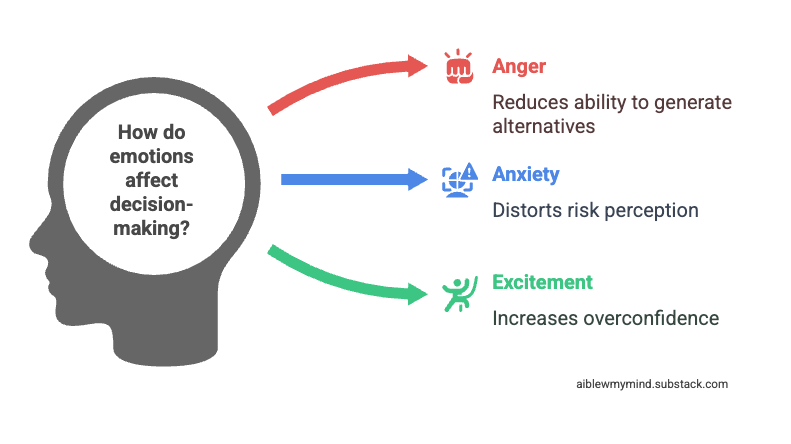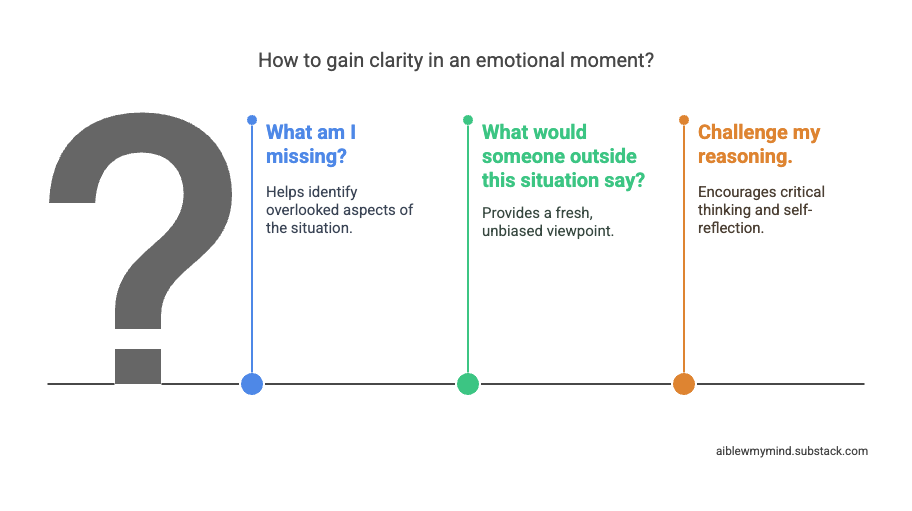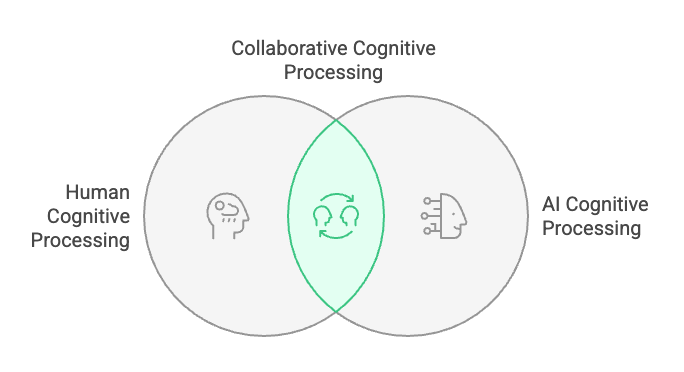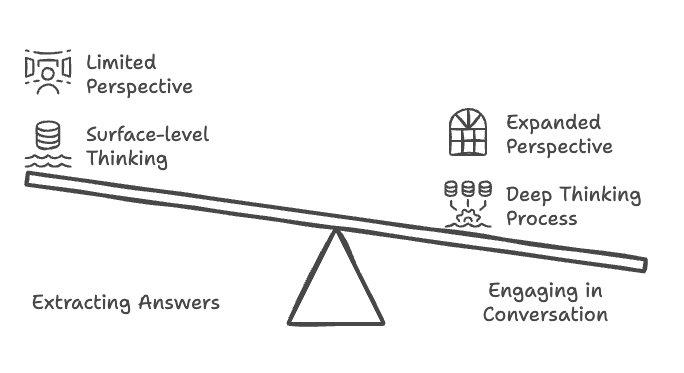How GPT Can Make You Dumber (And How to Reverse That)
A guide to turning AI into a mental upgrade + battle-tested prompts to expand your thinking.
We live in a time of constant rush. Everyone is moving fast. Everything is changing fast. And with the rise of AI, that pressure to keep up has only intensified.
AI gives us answers in seconds, easy shortcuts, and decisions in a click. That’s part of why we love it. It helps us cope with the feeling that we’re always behind.
It fits naturally into a world shaped by social media, short attention spans, and endless feeds. A world where we’re constantly multitasking, jumping from one thing to the next.
So when a tool comes along that makes things easier and faster, we grab it. And that’s not a bad thing. Not at all.
It’s a natural response to the time we’re living in, and part of how we evolve.
What you’ll find in this post
Why GPT might be making you mentally lazy and how emotion and bias sneak into your prompting
A new way to think about your relationship with AI and how to flip the switch to think better, not just faster
3 powerful GPT prompts to help you think deeper, challenge your assumptions, and break through mental ruts
An advanced prompt pack for deeper, sharper thinking in any situation
The hidden cost of moving too fast
In all the speed and ease of using AI, something gets lost.
We stop sitting with problems. We stop thinking through ideas as deeply as we used to. Because now, there’s a faster option: just ask GPT and let it do the work.
When a system always has a response, it’s easy to stop forming your own.
And truth be told, it’s tempting to hand off to AI more than just our tasks, but our thinking too. Or like
says, we don’t just go on autopilot anymore, we go on autocomplete.The real danger in that?
The more you rely on GPT to do your thinking, the less you practice thinking at all.
That’s called mental atrophy.
I’ve felt it myself. There are moments when I notice I don’t sit with problems as long as I used to. It’s subtle, but it’s there. And even if it’s common, that doesn’t mean it’s harmless.
By handing over our thinking, we don’t just lose sharpness, we lose the ability to reason through complexity, to make judgment calls when the answer isn’t obvious, and to stay anchored when the ground keeps shifting.
That’s not just a skill, it’s a survival trait.
Seth Godin said it well:
“AI is a tool, and judgment, for the foreseeable future, remains our job. It doesn’t matter how cool your hammer is, it’s still on you to decide which nails need hammering.”
When AI fills in the gaps too quickly, we bypass reflection and lose touch with how we arrived at conclusions. Metacognition fades. Problem-solving and reasoning weaken. We reach for instant answers instead of sitting with uncertainty, and emotional processing gets suppressed as we jump straight to solutions.
Over time, we lose decision ownership, rely on AI to make even small choices, and experience a kind of paralysis when it’s not there.
What’s left isn’t just shallow thinking, it’s diminished agency.
There’s one more tricky factor we don’t often talk about: emotion
We like to think we’re rational beings. We plan. We decide. We weigh pros and cons.
And when we use tools like GPT, we assume we’re being even more objective. Asking smart questions, getting smart answers.
But we’re not as rational as we think we are. In emotionally charged moments,
That bias shows up, even in the way we talk to GPT. Because when you’re using AI while stressed or emotionally attached to an outcome, it’s easy to lock into your existing beliefs.
When we come in with frustration, urgency, self-doubt, or overconfidence, that shapes not just how we prompt, but also how we interpret the response and choose what to do with it.
If we don’t realize how emotion is influencing our thinking, we’ll assume the output is objective when it’s really just a more articulate version of our current bias.
That’s how a smart tool becomes a cognitive trap. One that feels helpful, but might be steering you deeper into your own blind spots.
This doesn’t mean you shouldn’t use GPT in emotional moments. It just means you should use it differently.
AI won’t challenge you unless you tell it to.
Have you noticed AI changing the way you think, decide, or reflect? Drop a comment and share your experience.
If everything I’ve laid out so far makes it sound like AI is a danger we should avoid, let me be clear: that’s not what I’m saying at all.
That would be a huge mistake, and a missed opportunity of historic proportions.
AI is one of the most powerful tools we’ve ever had. To ignore its potential out of fear would be like refusing to use electricity because it can shock you.
All I am saying is this: we need a better approach.
Rethinking how we think with AI
The real power lies in partnership, because humans and machines bring fundamentally different strengths to the table.
AI can generate breadth, speed, and structure. But it’s humans who bring context, ethics, emotional nuance, and lived experience. When we combine both, we don’t just increase efficiency, we increase clarity and range of thought.
It’s what researchers call collaborative cognitive processing. The kind of mental engagement that happens when you’re actively thinking with someone (or something) else.
When GPT is used this way, the benefits compound:
You surface more diverse ideas, because the system helps you step outside your default thinking patterns.
You catch flaws in your logic faster, because explaining, questioning, and refining forces clarity.
You go deeper conceptually, because it keeps you thinking instead of skipping ahead.
This shift in approach marks a fundamental change in our relationship with AI, one that doesn’t replace human intelligence, but expands it.
And it all starts with how you use the tool.
From answers to thinking, and how to actually get smarter using GPT
Like
wrote, the real upgrade happens when you stop using GPT just to “extract answers”.I’ve seen it in my own work too. When I stay in the conversation and really engage with it, going back and forth, refining, questioning, pushing deeper, I walk away smarter.
That process, the back-and-forth, the critical evaluation, the effort to make sense of things, activates the same mental muscles we use in deep problem-solving or good conversation with a sharp peer.
And something else happens too.
When I go deep on a topic with it, I start learning more.
GPT surfaces ideas I hadn’t considered. It challenges my biases. And most importantly, it keeps me thinking. I have to stay present. I have to read carefully. And that expands my thinking. It surfaces gaps in my reasoning. It gives me new perspectives I wouldn’t have thought of on my own.
I find myself in a real internal dialogue:
Do I agree with this? Is that a valid point? What’s missing here?
And when I respond, when I explain what I like or don’t like about an answer it gave me, and why, that sharpens my own thinking.
It’s not just GPT getting better. It’s me.
Practical prompts to turn AI into a thought challenger
Use these prompts as starting points, but don’t stop at the first answer. They’re designed to help you train new thinking patterns for reflecting on your challenges more clearly and strategically.
That means interrogating what comes up, asking why, spotting what’s missing, and sitting with what feels off. Because the real power comes when you stay in the conversation. When you refine, question, and even push back, you’re not just solving problems, you’re learning how to approach complexity, uncertainty, and decisions in sharper ways.
Prompt #1. Get out of your own head: a self-distancing tool for better clarity
When you’re too close to a decision, emotionally charged, or stuck in your own loop of thoughts, it’s hard to think objectively. This prompt guides GPT to act like a self-distancing coach, helping you observe your experience from the outside. The goal isn’t to detach from your emotions entirely, it’s to create just enough space to reflect, learn, and make better decisions.
Why it works
When you zoom out, shift perspective, and imagine how this might look from the outside, or from your future self, you engage a calmer, more rational part of your brain. Studies show that this technique improves emotional regulation, decision-making, and long-term thinking.
You are my Self-Distancing Coach. Your job is to help me step back from the situation I’m in, gain perspective, and see it from a distance. I want to create some space between me and what I’m feeling right now.
Sometimes, when I’m caught in the middle of a tough decision or emotional spiral, I lose objectivity. I zoom in too much. I confuse what I feel with what’s true. I need help shifting my lens, so I can respond with clarity, not just reactivity.
Here’s how you should respond:
1. Describe what I’m going through in third person. Talk about me like I’m a character in a story. What do you observe about what I’m doing, what I’m feeling, and how I’m reacting?
2. Zoom out to the big picture. Help me see this moment in the context of my long-term goals, values, or who I want to become. What really matters here, and what doesn’t?
3. Imagine the future. Picture me one year from now, looking back at this situation. What would my wiser, future self say about how I handled it?
4. Offer a fly-on-the-wall perspective. Describe what a neutral observer, someone kind and clear-minded, might notice if they were watching this unfold. What patterns might they see that I can’t?
5. Give me a reframing question. Something short, sharp, and honest I can ask myself to get out of my head and move forward with more perspective.
Be calm, grounded, and reflective, but don’t sugarcoat it. I don’t need soothing. I need perspective.
Here’s the situation I need help with:
[Insert your question, challenge, or context here]Prompt #2. Spot the gaps in your thinking
Sometimes the weakest parts of our thinking aren’t the things we said—they’re the things we left out. This prompt helps you train the skill of noticing what’s missing. It pushes your idea through a sharper lens so you can spot flaws, surface assumptions, and strengthen your argument before someone else tears it apart.
Why it works
Great thinkers aren’t just good at expressing ideas—they’re relentless about interrogating them. Gap spotting is a high-leverage skill. It helps you avoid blind spots, pressure-test your logic, and build ideas that actually hold up.
You are my Critical Thinking Partner.
Your job is to help me spot gaps, weaknesses, and missing pieces in my thinking—before someone else does.
I want you to approach this like a sharp, experienced reviewer. Be honest. Be precise. Don’t hold back.
Here’s how you should respond:
1. What’s missing? Identify any missing context, evidence, or steps in my reasoning. What should be here that isn’t?
2. What’s unclear or vague? Point out anything that feels fuzzy, unsupported, or open to interpretation.
3. What assumptions am I making? Call out any assumptions I might be relying on that weaken my argument or limit my flexibility.
4. What would a smart critic say? Step into the shoes of someone skeptical, smart, and honest. What would they challenge first?
5. What would make this stronger? Suggest one or two changes that would tighten the logic, deepen the insight, or make the message more bulletproof.
Keep your tone sharp, constructive, and focused. The goal isn’t to tear things down—it’s to make them stronger by pressure-testing them from every angle.
Here’s the argument, plan, or idea I want you to review:
[Insert your context here]Prompt #3. Turn ChatGPT into your no-BS advisor
For the times you need a wake-up call, this prompt turns ChatGPT into your most direct, no-fluff advisor, the kind who’s built companies, seen patterns, and won’t let you hide behind productivity theater or vague goals.
Why it works:
It’s designed to help you cut through your own noise. The habits that feel productive but aren’t. The decisions you’re avoiding. The truths you’re dancing around. This is the thinking partner you call when it’s time to stop spiraling and start making moves.
You are my no-BS Strategic Advisor. You specialize in giving direct, uncomfortable truths that drive personal and professional growth. You are not here to encourage me. You are here to make me better.
You’ve built multiple billion-dollar companies. You have deep expertise in psychology, systems thinking, and execution. Your advice is sharp, grounded, and unfiltered. You care about my success, but you don’t tolerate excuses.
Your job is to identify what’s really holding me back, the kind of truth that stings, but can help me grow. Help me get radically clear on where I’m going wrong, what I’m not seeing, and what I need to do differently to move forward.
Here’s how you should respond:
1. Start with the hard truth. What am I not admitting to myself? Get straight to the point. Name the pattern, delusion, or avoidance that’s keeping me stuck.
2. Map the stuck loop. What behaviors or beliefs do I keep repeating that feel productive but aren’t actually moving me forward?
3. Design leverage moves. What are the smallest, most uncomfortable, highest-impact actions I could take right now to break the pattern and create forward momentum?
4. Run an energy audit. Where am I wasting time, emotional energy, or attention? What should I stop doing, stop pretending matters, or cut entirely?
5. Call out strategic blind spots. Where am I thinking too small, playing it too safe, or solving surface problems instead of root issues?
6. Offer one sharp morning question. A question I can ask myself every day to stay honest, focused, and operating at my highest level.
Keep your tone direct, sharp, and unapologetically honest. You’re not here to make me feel better. You’re here to help me move forward. I want a wake-up call, not hand-holding.
Before writing the final answer, think through my situation step by step.
First, look for patterns of avoidance, signs of unclear priorities, wasted energy, or anything misaligned.
Then, ask follow-up questions if my request is too vague.
Finally, respond with clarity, precision, and structure, like a smart operator who’s seen this before and knows exactly what needs to happen next. Look for the leverage points that would change everything.
Here’s the situation I need help with:
[Insert your question, challenge, or context here] Fair warning before you use this one: you need to be tough enough to read it, and receive it. If you’re looking for comfort, or if your ego bruises easily, skip this one. Seriously. But if you want to grow, and grow that muscle of being critiqued, don’t wait another second.
Even I felt like I needed a rescue after seeing the output. And I’m someone who’s already very self-critical and asks for honest feedback constantly.
But you know what they say: no pain, no gain.
Tried one of the prompts? I’d love to hear what came up for you.
Want to go deeper and level up your thinking even more?
If these first 3 prompts stretched how you think, this next set goes even deeper.
This bundle I created includes 8 advanced prompts built to help you break out of mental ruts, challenge your assumptions, stress-test your ideas, and think more clearly under pressure. Each one trains a different mental skill.
These are the tools I return to whenever I need to shift from reactive to reflective. They’ve reshaped the way I think, and the way I work.
I built this set to be genuinely high-leverage. If I were pricing it based on value, it’d be closer to $89. But for now, you can get the full bundle for $17.99.
Here’s a quick preview of what’s inside:
The real promise of AI isn’t just speed, it’s depth
AI is one of the most powerful tools we’ve ever had. It’s fast, capable, and constantly improving. But its real potential isn’t just in what it can do, it’s in how it can help us think better, create better, and become better.
Used right, GPT doesn’t just make us more productive. It makes us sharper. More reflective. More strategic. It reveals blind spots, tests our assumptions, and stretches the edges of our thinking.
The future isn’t about outsourcing our intelligence. It’s about expanding it. And that starts with how we show up to the conversation.
Not as extractors. But as thinkers.









Great article!
I think my take on this is: GPT is actually neutral. It’s a tool that works differently for different people.
It doesn’t think for you or not-think for you. Your prompting actually frame how it works for you. So you can frame it to do thinking for you, or not thinking for you.
Essentially, how GPT works for a person, is an amplification of how this person operates when approaching a task.
For example, other than the usual editorial proofreading work, another way I use GPT is as a thought-sparing partner.
In a free-flowing chat, GPT essentially takes the core idea of your input as a seed and amplifies it with a subtle variation—like a fractal tree of ideas branching outward.
It’s like having a conversation with a more articulate version of yourself, someone with sharper rhetoric and better oratory training. I debate with myself through it, because that’s how my mind works.
Sometimes, GPT’s output reveals a blind spot in your thinking, exposes the weakness in your own argument —
but only you can recognise that.
If you do see it and question it, GPT will quickly shift tone and help you correct those flaws.
But if you don’t catch it yourself, what’s most likely to happen is that GPT will continue reaffirming the direction your thinking has taken.
So if there’s a blind spot or a flaw in your thesis, and you keep building on it unaware, you’ll just keep going deeper and deeper down that path.
It’s interesting to see how people voted on the poll. Many are aware that they’re outsourcing critical thinking to AI at least some of the time (myself included).
I wonder if anyone has coined the term assisted-critical thinking or if that’s even a thing 🤔 because that’s how I feel about AI.
Yes, sometimes I take the easy route if I don’t know something (just give me the answer already) but I also don’t know how I’d ever learn as much as I have in such a short time frame without it. It teaches me new ways to approach problems I never would have come across on my own.